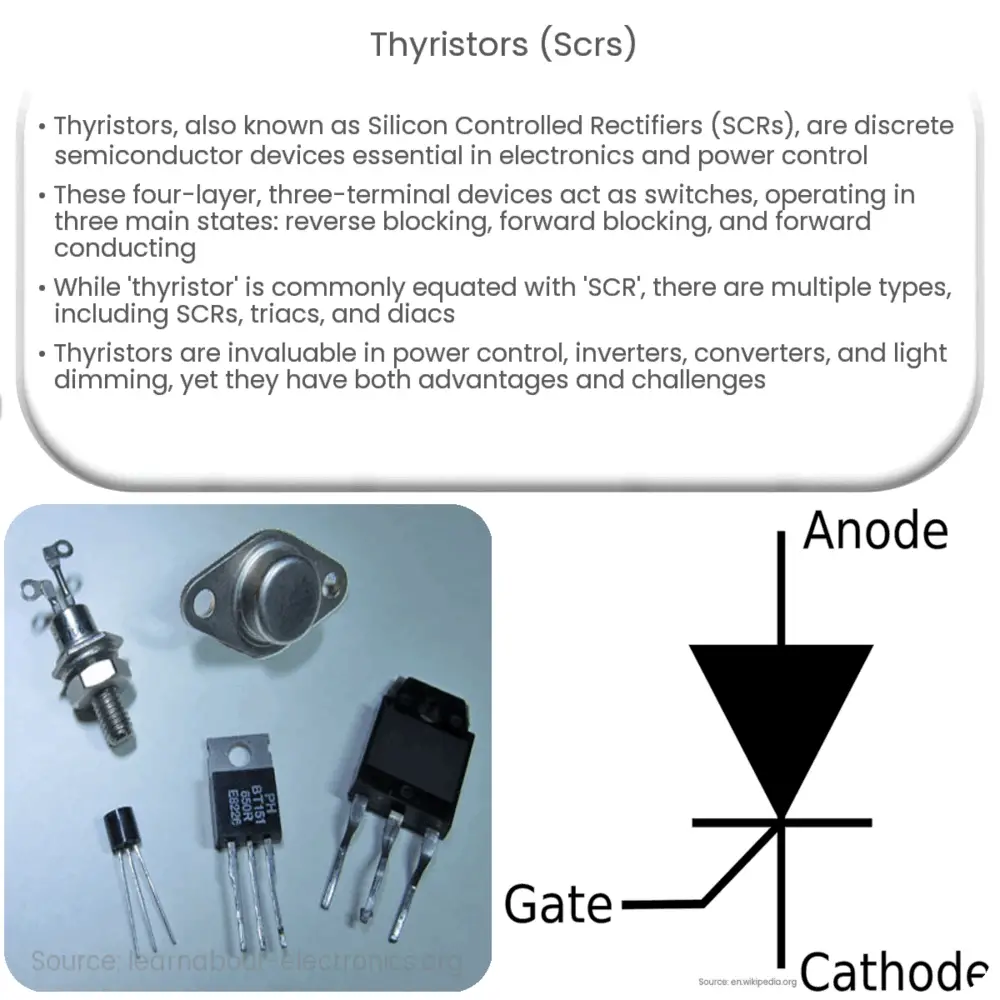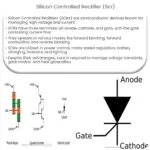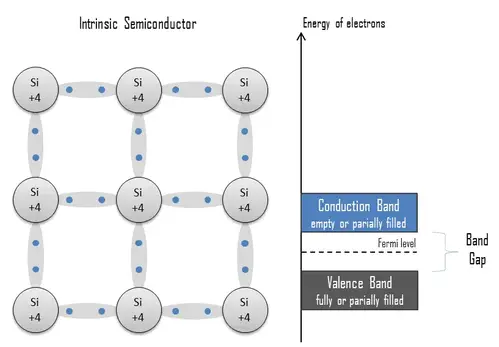Explore the world of thyristors (SCRs), their operating principles, types, applications, advantages and disadvantages in our comprehensive guide.

Introduction to Thyristors (SCRs)
Thyristors, commonly referred to as Silicon Controlled Rectifiers (SCRs), are a unique type of discrete semiconductor devices. They play a pivotal role in the realm of electronics and power control, acting as vital components in a wide array of applications.
Understanding Thyristors
Thyristors are essentially four-layer, three-terminal devices composed of alternating p-type and n-type semiconductor materials. They consist of three junctions denoted as J1, J2, and J3. The three terminals are the anode, cathode, and gate. These components operate as a switch, conducting when their anode voltage is greater than the cathode, and the gate pulse is applied.
Operating Principles
The operation of a thyristor can be broken down into three main states: Reverse blocking mode, Forward blocking mode, and Forward conducting mode.
- Reverse blocking mode: In this state, the cathode is positive with respect to the anode. If a voltage is applied across the thyristor in this direction, no current will flow, rendering the thyristor “off”.
- Forward blocking mode: Here, the anode is positive relative to the cathode but with no gate current. Despite the correct direction of voltage, without a gate current, the thyristor remains non-conductive.
- Forward conducting mode: In this state, the anode is positive in relation to the cathode and a gate current is present. This initiates the “on” state, allowing the thyristor to conduct current.
Types of Thyristors
While the term ‘thyristor’ is often synonymously used with ‘SCR’, there are, in fact, several types of thyristors.
- Silicon Controlled Rectifiers (SCRs): SCRs are the most common type of thyristor. They conduct current in only one direction, functioning as a unidirectional device.
- Triacs: Unlike SCRs, triacs are bidirectional, capable of conducting current in both directions.
- Diacs: Diacs are also bidirectional devices but are often used as a trigger for triacs.
Applications of Thyristors
The unique properties of thyristors make them a popular choice in various applications within both the industrial and domestic arena.
- Power Control: The high current carrying capability and the ability to withstand large voltages make thyristors an ideal choice for power control applications. This includes devices such as motor speed controllers, liquid level regulators, and pressure control systems.
- Inverters and Converters: Thyristors are also commonly used in power electronics, such as inverters and converters, to convert AC to DC and vice versa.
- Light Dimming: In the domestic arena, thyristors find their use in light dimming circuits. The controlled conduction of the thyristor allows for the regulation of light output.
Advantages and Disadvantages of Thyristors
Like all devices, thyristors too come with their own set of pros and cons.
- Advantages: Thyristors offer high efficiency and reliability. They have a high voltage and current handling capacity, and exhibit a fast switching speed. These attributes make them an excellent choice for power control applications.
- Disadvantages: On the downside, thyristors have latching and holding current issues. They cannot be used in DC circuits without adding additional circuitry. Moreover, the control on a thyristor is unidirectional, which can limit its functionality in certain applications.
Conclusion
In conclusion, thyristors, especially Silicon Controlled Rectifiers (SCRs), are an integral part of modern electronics. They have enabled advancements in various areas ranging from industrial power control to everyday domestic appliances. However, despite their numerous advantages, the challenges that thyristors present call for constant innovation and improvements. As the field of electronics continues to evolve, we can anticipate the emergence of more sophisticated and efficient variants of these remarkable devices.



